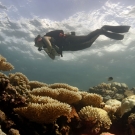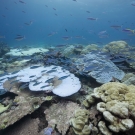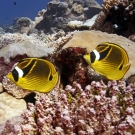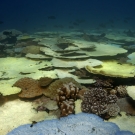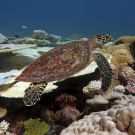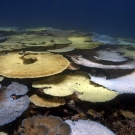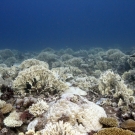Cotton Candy Corals
A mass bleaching event in the Indian Ocean turns corals cotton-candy shades of pink and blue
Written by Elizabeth Rauer
The phrase ‘coral-bleaching’ brings to mind ghostly-white skeletons of coral but what we found when we dived on reefs in the British Indian Ocean Territory (BIOT) was something totally different. While surveying reefs in BIOT on the Global Reef Expedition, we encountered a period of warm, calm weather. As the water slowly began to warm to something resembling bath water, the coral started to bleach. What surprised us most about the bleaching was that some corals turned vibrant cotton-candy shades of pink and blue.
We are now in the middle of a global coral bleaching event – only the third one in recorded history – and with El Nino conditions predicted to persist well into 2016, bleaching could get even worse. Earlier this year we reported a mass bleaching in the Indian Ocean – the first of the year, and perhaps a sign of worse to come. Early reports estimate that up to 1/3 of coral reefs around the globe could bleach within the next year.
Corals have a co-dependent relationship with symbiotic algae called zooxanthellae. Bleaching occurs when corals become stressed and lose the symbiotic algae (or just their pigments) that live inside coral tissue, often caused by prolonged exposure to unusually warm water. Theories abound as to exactly why corals and their symbiotic algae separate under stress. In some cases it could be that the algae are in search of a more hospitable home, or it could be the corals expel their algae in hopes of finding another better suited to their current conditions (zooxanthellae release a dangerous amount of free radicals when stressed, and some clades are better at dealing with high temperatures than others). Bleaching also appears to be associated with a number of other stressors, such as light exposure or pollution, which may make the corals more susceptible to bleaching when warm waters do occur.
Whatever the reason for bleaching, when a coral loses their symbiotic algae, they also lose their color. Most of the brilliant colors of coral come from the algae that live inside their tissues. However, the bright blues and pinks we saw corals displaying in BIOT came from chromophores inside the coral tissue.
Chromatophores are pigmented or light-reflecting proteins many corals possess. Scientists believe these proteins can act as coral sunscreen. Some chromatophores absorb potentially harmful light of one color (wavelength) and emit (fluoresce) a different (lower energy wavelength) color. There are more than 85 fluorescent pigments that are produced by corals, they usually appear blue, green, yellow or red, and will glow when viewed with certain types of lights (check out some amazing images of fluorescing corals from iLCP photographer Jürgen Freund). When a coral is stressed, fluorescence rapidly declines. If the coral can acclimate, fluorescence will slowly recover to pre-stress levels. However, if the coral bleaches, fluorescence will dramatically increase to compensate for the substantial loss of symbiotic algae that would otherwise shade the coral from harmful UV light.
Most bleaching events are predominately due to increases in temperature. Here, due to the extreme water clarity and calm conditions, light played a major role in the bleaching – and this may be why the corals increased their production of chromatophores (and why we saw such brilliantly colored corals).
Once corals bleach, they only have a short period of time to recover before they die of starvation. Fortunately for the reefs in BIOT, cooler waters retuned within a few weeks and our scientists believe this enabled most of the corals to recover. We only hope that many other reefs affected by the global bleaching event will be so lucky.
Photos by Philip G. Renaud and Derek Manzello








